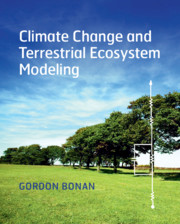Refine listing
Actions for selected content:
2285 results in Ebooks in ecology and environment
15 - Plant Canopies
-
- Book:
- Climate Change and Terrestrial Ecosystem Modeling
- Published online:
- 08 February 2019
- Print publication:
- 21 February 2019, pp 260-279
-
- Chapter
- Export citation
Case D - Angry Bulbs
-
-
- Book:
- Environmental Expertise
- Published online:
- 22 February 2019
- Print publication:
- 21 February 2019, pp 117-125
-
- Chapter
- Export citation
16 - Scalar Canopy Profiles
-
- Book:
- Climate Change and Terrestrial Ecosystem Modeling
- Published online:
- 08 February 2019
- Print publication:
- 21 February 2019, pp 280-300
-
- Chapter
- Export citation
Reviews
-
- Book:
- Environmental Expertise
- Published online:
- 22 February 2019
- Print publication:
- 21 February 2019, pp ii-ii
-
- Chapter
- Export citation
9 - Hydrologic Scaling and Spatial Heterogeneity
-
- Book:
- Climate Change and Terrestrial Ecosystem Modeling
- Published online:
- 08 February 2019
- Print publication:
- 21 February 2019, pp 134-151
-
- Chapter
- Export citation
11 - Leaf Photosynthesis
-
- Book:
- Climate Change and Terrestrial Ecosystem Modeling
- Published online:
- 08 February 2019
- Print publication:
- 21 February 2019, pp 167-188
-
- Chapter
- Export citation
19 - Vegetation Demography
-
- Book:
- Climate Change and Terrestrial Ecosystem Modeling
- Published online:
- 08 February 2019
- Print publication:
- 21 February 2019, pp 344-364
-
- Chapter
- Export citation
5 - Soil Temperature
-
- Book:
- Climate Change and Terrestrial Ecosystem Modeling
- Published online:
- 08 February 2019
- Print publication:
- 21 February 2019, pp 64-79
-
- Chapter
- Export citation
10 - Environmental Knowledge in Democracy
-
-
- Book:
- Environmental Expertise
- Published online:
- 22 February 2019
- Print publication:
- 21 February 2019, pp 247-256
-
- Chapter
- Export citation
Copyright page
-
- Book:
- Climate Change and Terrestrial Ecosystem Modeling
- Published online:
- 08 February 2019
- Print publication:
- 21 February 2019, pp iv-iv
-
- Chapter
- Export citation
Preface
-
- Book:
- Climate Change and Terrestrial Ecosystem Modeling
- Published online:
- 08 February 2019
- Print publication:
- 21 February 2019, pp xiii-xiv
-
- Chapter
- Export citation
Table A.2 - Metric prefixes
- from Appendices
-
- Book:
- Climate Change and Terrestrial Ecosystem Modeling
- Published online:
- 08 February 2019
- Print publication:
- 21 February 2019, pp 381-381
-
- Chapter
- Export citation
10 - Leaf Temperature and Energy Fluxes
-
- Book:
- Climate Change and Terrestrial Ecosystem Modeling
- Published online:
- 08 February 2019
- Print publication:
- 21 February 2019, pp 152-166
-
- Chapter
- Export citation
Table A.1 - Basic and derived scientific units
- from Appendices
-
- Book:
- Climate Change and Terrestrial Ecosystem Modeling
- Published online:
- 08 February 2019
- Print publication:
- 21 February 2019, pp 381-381
-
- Chapter
- Export citation
8 - Lay Expertise
-
-
- Book:
- Environmental Expertise
- Published online:
- 22 February 2019
- Print publication:
- 21 February 2019, pp 184-199
-
- Chapter
- Export citation
Case I - The Loweswater Care Project
-
-
- Book:
- Environmental Expertise
- Published online:
- 22 February 2019
- Print publication:
- 21 February 2019, pp 210-221
-
- Chapter
- Export citation
13 - Plant Hydraulics
-
- Book:
- Climate Change and Terrestrial Ecosystem Modeling
- Published online:
- 08 February 2019
- Print publication:
- 21 February 2019, pp 213-227
-
- Chapter
- Export citation
Contents
-
- Book:
- Environmental Expertise
- Published online:
- 22 February 2019
- Print publication:
- 21 February 2019, pp v-viii
-
- Chapter
- Export citation

Climate Change and Terrestrial Ecosystem Modeling
-
- Published online:
- 08 February 2019
- Print publication:
- 21 February 2019
Contents
-
- Book:
- Anthropocene Encounters: New Directions in Green Political Thinking
- Published online:
- 21 January 2019
- Print publication:
- 07 February 2019, pp v-vi
-
- Chapter
- Export citation
